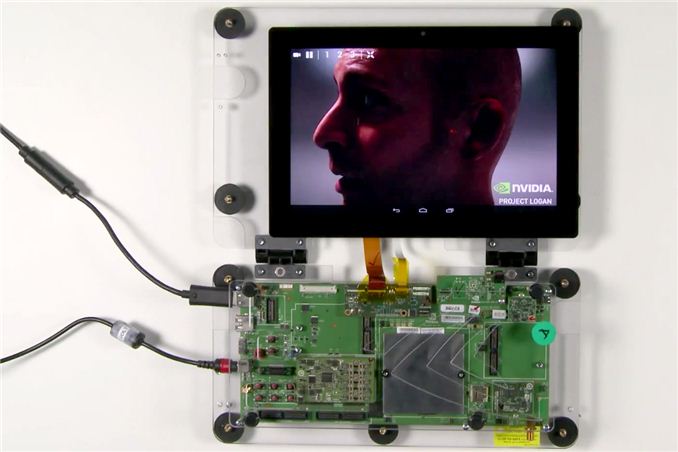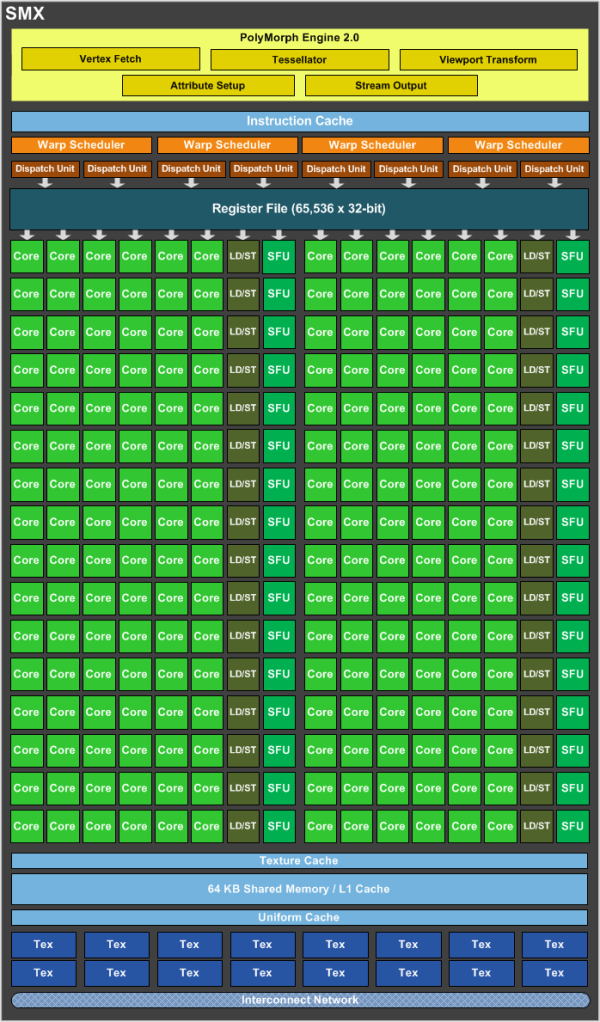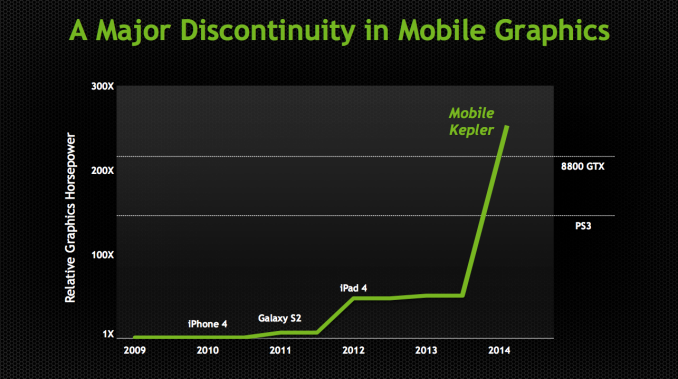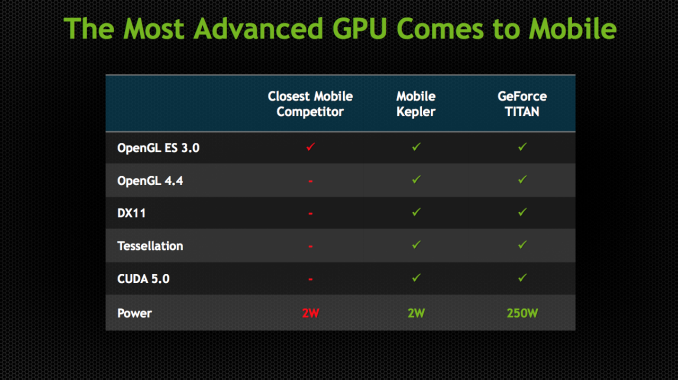NVIDIA Demonstrates Logan SoC: < 1W Kepler, Shipping in 1H 2014, More Energy Efficient than A6X?
by Anand Lal Shimpi on July 24, 2013 9:00 AM EST
Ever since its arrival in the ultra mobile space, NVIDIA hasn't really flexed its GPU muscle. The Tegra GPUs we've seen thus far have been ok at best, and in serious need of improvement at worst. NVIDIA often blamed an immature OEM ecosystem unwilling to pay for the sort of large die SoCs necessary in order to bring a high-performance GPU to market. Thankfully, that's all changing. Earlier this year NVIDIA laid out its mobile SoC roadmap through 2015, including the 2014 release of Project Logan - the first NVIDIA ultra mobile SoC to feature a Kepler GPU. Yesterday in a private event at Siggraph, NVIDIA demonstrated functional Logan silicon for the very first time.
NVIDIA got Logan silicon back from the fabs around 3 weeks ago, making it almost certain that we're dealing with some form of 28nm silicon here and not early 20nm samples.
NVIDIA isn't talking about CPU cores, but it's safe to assume that Logan will be another 4+1 arrangement of cores - likely still based on ARM's Cortex A15 IP (but perhaps a newer revision of the core). On the GPU front, NVIDIA confirmed our earlier speculation that Logan includes a single Kepler SMX:
One Kepler SMX features 192 CUDA cores. NVIDIA isn't talking about shipping GPU frequencies either, but it did provide this chart to put Logan's GPU capabilities into perspective:
Don't get too excited as we're looking at a comparison of GFLOPS and not game performance, but the peak theoretical ALU bound performance of mobile Kepler should exceed that of a Playstation 3 or GeForce 8800 GTX (memory bandwidth is another story however). If we look closely at NVIDIA's chart and compare mobile Kepler to the iPad 4, we get a better idea of what sort of clock speeds NVIDIA would need to attain this level of performance. Doing some quick Photoshop estimation it looks like NVIDIA is claiming mobile Kepler has somewhere around 5.2x the FP power of the PowerVR SGX 554MP4 in the iPad 4 (76.8 GFLOPS). That works out to be right around 400 GFLOPS. With a 192 core implementation of Kepler, you get 2 FLOPS per core or 384 FLOPS per cycle. To hit 400 GFLOPS you'd need to clock the mobile Kepler GPU at roughly 1GHz. That's certainly doable from an architectural standpoint (although we've never seen it done on any low power 28nm process), but it's probably a bit too high for something like a smartphone.
NVIDIA didn't want to talk frequencies but they did tell me that we might see something this fast in some sort of a tablet. I suspect that most implementations will be clocked significantly lower. Even at half the frequency though, we're still talking about roughly Playstation 3 levels of FP power out of a mobile SoC. We know nothing of Logan's memory subsystem, which obviously plays a major role in real world gaming performance but there's no getting around the fact that Logan's Kepler implementation means serious business. For years we've lamented NVIDIA's mobile GPUs, Logan looks like it's finally going to change that.
API Support and Live Demos
Unlike previous Tegra GPUs, Kepler is a fully unified architecture and OpenGL ES 3.0, OpenGL 4.4 and DirectX 11 compliant. The API compliance alone is a huge step forward for NVIDIA. It's also a big one for game developers looking to move more seriously into mobile. Epic's Tim Sweeney even did a blog post for NVIDIA talking about Logan's implementation of Kepler and how it brings feature parity between PCs, next-gen consoles and mobile platforms. NVIDIA responded in kind by running some Unreal Engine 4 demos on Android on a Logan test platform. That's really the big story behind all of this. With Logan, NVIDIA will bring its mobile GPUs up to feature parity with what it's shipping in the PC market. Game developers looking to port games between console, PC, tablet and smartphone should have an easier job of doing that if all platforms supported the same APIs. Logan will take NVIDIA from being very behind in API support (with no OpenGL ES 3.0 support) to the head of the class.
NVIDIA took its Ira demo, originally run on a Titan at GTC 2013, and got it up and running on a Logan development board. Ira did need some work to make the transition to mobile. The skin shaders were simplified, smaller textures are used and the rendering resolution is dropped to 1080p. NVIDIA claims this demo was done in a 2 - 3W power envelope.
The next demo is called Island and was originally shown on a Fermi desktop part. Running on Logan/mobile Kepler, this demo shows OpenGL 4.3 and hardware tessellation working.
The development board does feature a large heatspreader, but that's not too unusual for early silicon just out of bring up. Logan's package size should be comparable to Tegra 4, although the die size will clearly be larger. The dev board is running Android and is connected to a 10.1-inch 1920 x 1200 touchscreen.













141 Comments
View All Comments
jasonelmore - Wednesday, July 24, 2013 - link
Keplar has the best performance per watt in the world. No matter which platform your talking about.This only makes sense, now keplar is fully scale-able.
Refuge - Thursday, July 25, 2013 - link
Thing is, its coming to market too late if you ask me, and to be perfectly honest I wouldn't expect it to do much more than perform equally with its competition.THe only thing I can see saving this and making it a huge success would be if the 20nm yields are crap and they can't make enough for demand.
Arnulf - Wednesday, July 24, 2013 - link
The name is Kepler, as in Johannes Kepler:http://en.wikipedia.org/wiki/Johannes_Kepler
takeship - Wednesday, July 24, 2013 - link
See also for reference: Tegra 2 performance claims, Tegra 3 power claims.godrilla - Wednesday, July 24, 2013 - link
This thing can run crysis 1 six years later 100x more efficient than my 6 year old 8800 ultra, now that is impressive.chizow - Wednesday, July 24, 2013 - link
I guess Logan is the reason why Nvidia was so confident in it's IP licensing overtures. Hopefully we'll see it licensed out to some of the bigger players out there. It'd be a shame to see Kepler mobile tech wasted away if it's necessarily tethered to Tegra.happycamperjack - Wednesday, July 24, 2013 - link
I believe that this is nvidia's marketing push to Apple. Everything nVidia's doing lately (such as opening up mobile GPU licensing) is pointing to nVidia wanting to bed with Apple products. If they are successful, we can expect Apple products to feature nVidia GPU in their late 2014 or 2015 lineups. Their PowerVR chips are lagging behind competitions in terms of cutting edge features like latest OpenGL implementations. Apple is no doubt looking into updating their GPU lines. Nvidia's GPU makes a lot of sense for Apple (experiences with TSMC SoC, lack of Android phones using nVidia's GPU this year).Krysto - Thursday, July 25, 2013 - link
I'm sure Apple would evaluate it. But I think they'll just wait for Maxwell, a year after that.I was already thinking Apple might quit Imagination in the next few years, because Imagination will be making their own MIPS chips, and try to get more into the Android world, and I don't think Apple will like that very much.
Plus, there's the technical reasons. I don't think Imagination will match Kepler/Maxwell anytime soon, probably not even in performance, let alone in features. It's really REALLY hard to support all the latest and advanced OpenGL features - see Intel, who's had tons of trouble making proper drivers over the years, and they're still barely at OpenGL 4.0 with Haswell.
happycamperjack - Thursday, July 25, 2013 - link
I guess it will all depends on how good PowerVR series 6 GPU will be. And who knows, might even use intel SoC in 2015 as the new 4.5w Haswell has been very impressive! If it has the performance near the i5 in Surface Pro, it's a no brainer for Apple to seriously consider Haswell or its successors. One thing for sure, it's gonna be harder than ever for Apple to figure out which road to take in the next 2 years.watersb - Friday, July 26, 2013 - link
Apple currently has the resources to take all the "roads", then pick the one that works best for them. All before releasing a product.Their culture of secrecy is mostly because they do not want clumsy ideas presented to the end-user.